Vans employees who attended an “all-hands event” in Los Angeles earlier this year were each gifted a high-end rugged chore jacket. But that was only the beginning.
The skating shoe and apparel brand hooked up with Ink + Cotton, an LA-based marketing agency that specializes in live decoration at events of all sizes. Ink + Cotton set up eight different stations where employees could have their jackets customized using everything from airbrushing to embroidery. There were screen-printing presses set up with “old-school throwback” logos and more modern brand art. There were patches and pinback buttons.
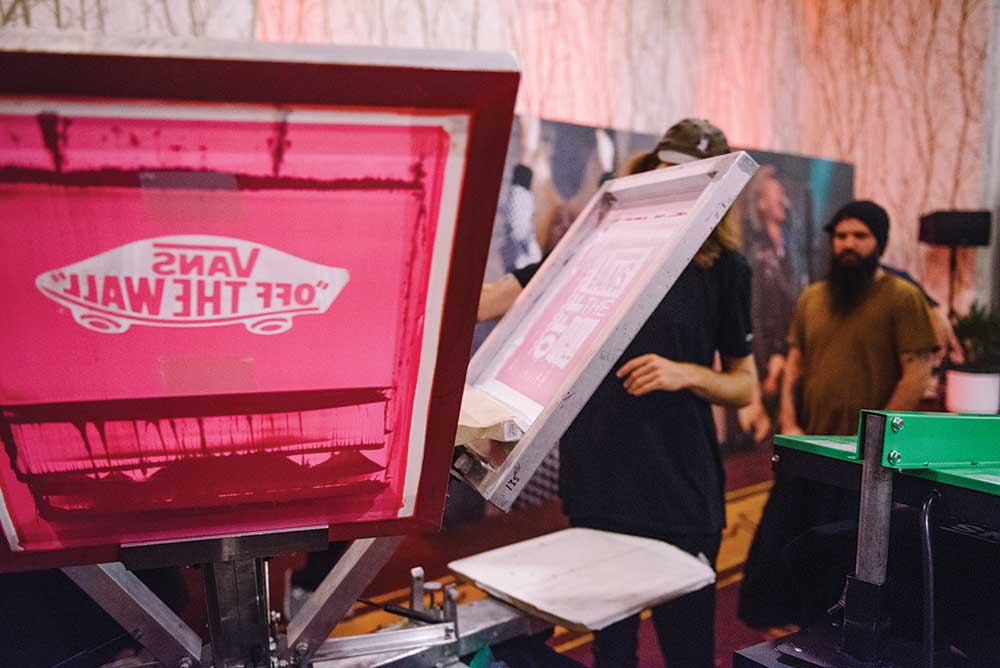

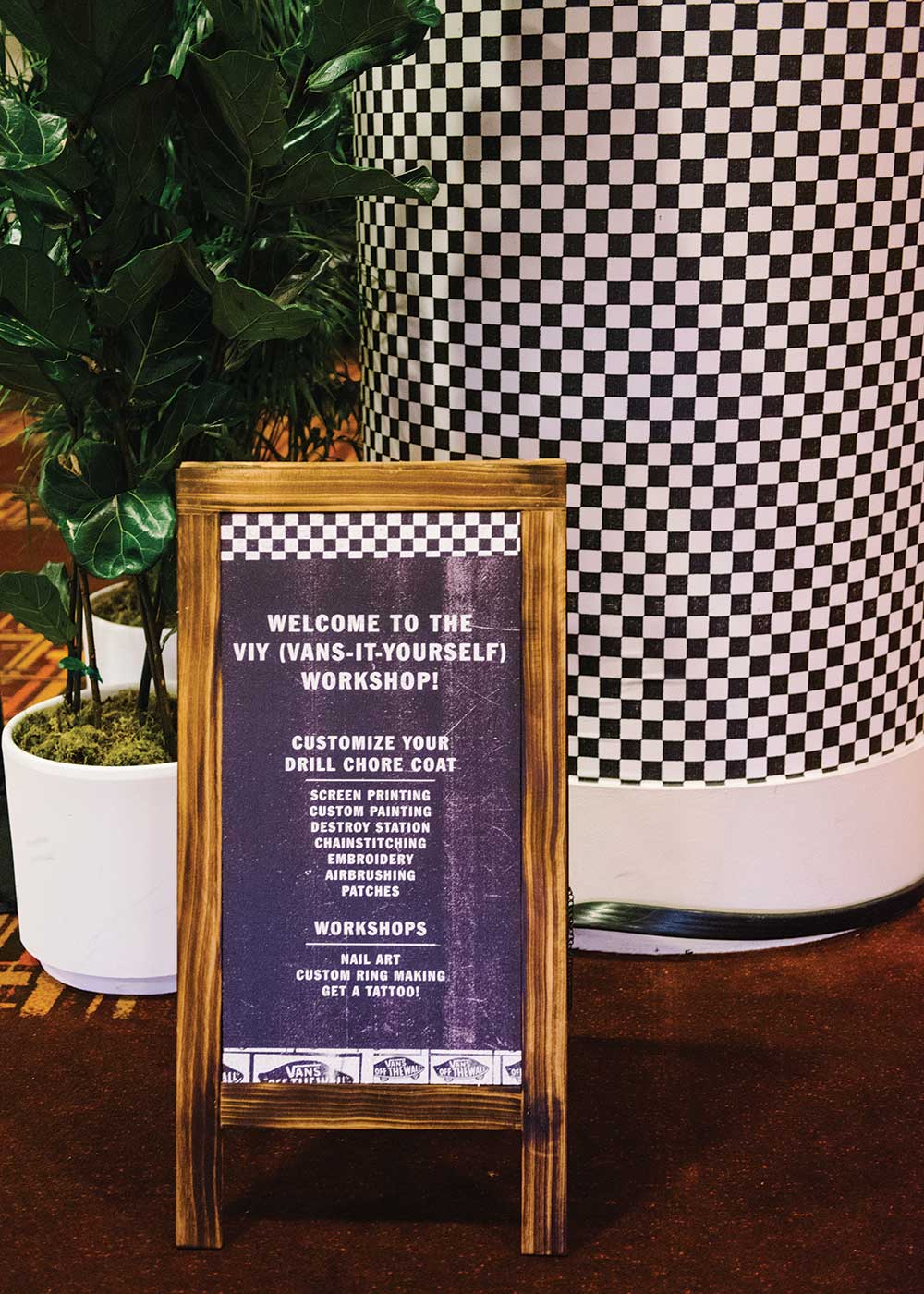
Ink + Cotton set up eight customization stations for Vans employees to create one-of-a-kind jackets.
“They didn’t have a rulebook saying you couldn’t do something,” says Kyle Ellis, founder of Ink + Cotton. “There were a lot of really unique takes on how to design your own jacket, things that going into it we didn’t think people were going to come up with” – like the employee who wanted the Vans logo repeated in rhinestones all the way down the sleeves.
The event was a clear hit. “You knew these people were going to wear that jacket,” Ellis says. “It wasn’t going to be a promotional T-shirt that got stuffed in a drawer at home.”
That’s the appeal of live event decoration. It combines two hot trends – experiential marketing and extreme customization – and transforms them into a tangible, beloved memento the wearer will associate warmly with the brand for years to come. “When people have the opportunity to take part and feel like they’re an asset in bringing something to life, there’s way more benefit to the brand,” says Lucas Guariglia, owner of Chicago-based apparel decorating firm Rowboat Creative (asi/313715). “People can get creative, and it gives them more brand buy-in.”
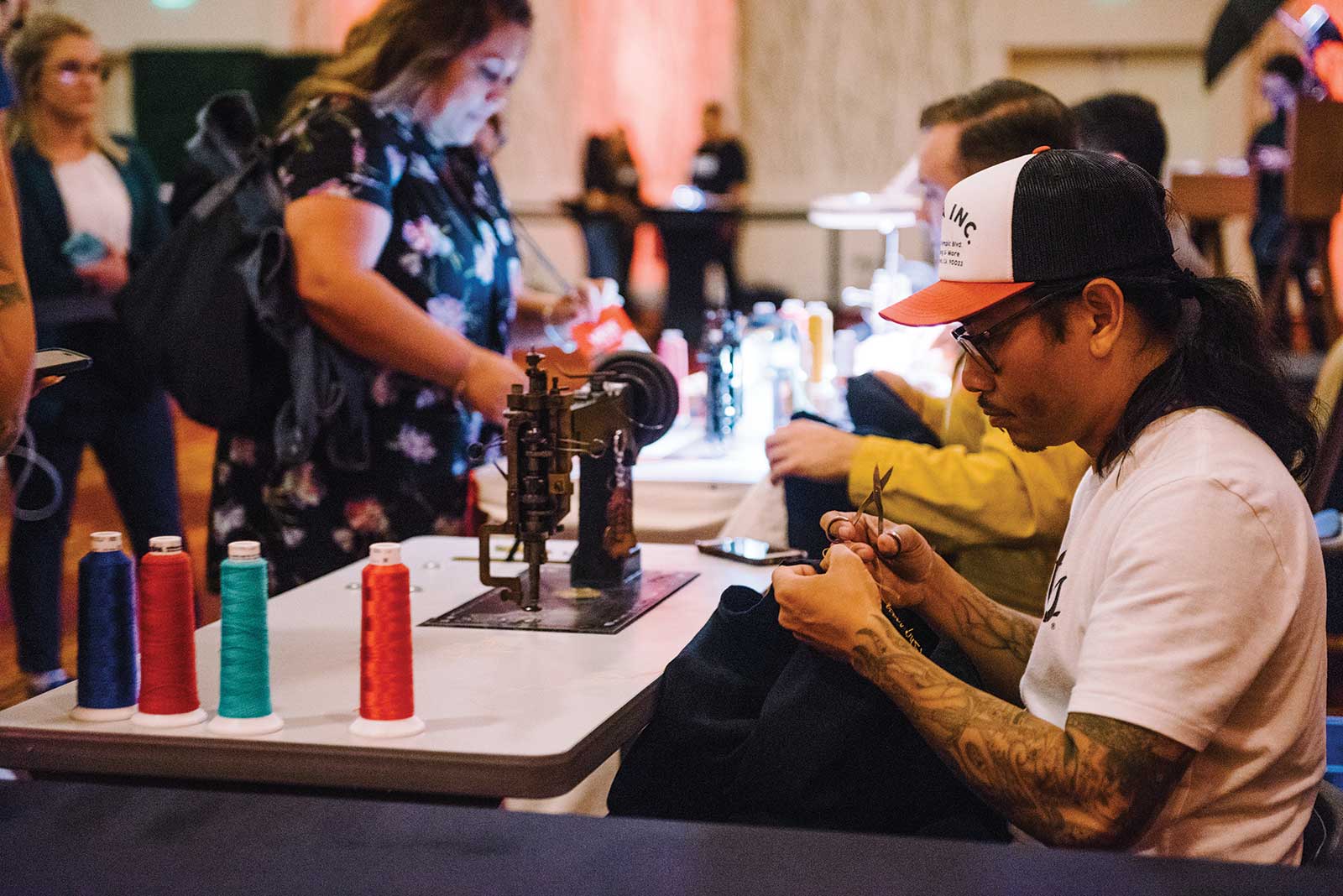
More and more brands have discovered the power of live decorating, deploying it at music festivals and other large-scale public-facing activities, or internally as part of company picnics or employee incentives. So what exactly makes this trend so valuable to marketers?
First off, the spectacle of the decoration itself is inherently “Instagrammable” and easily draws an eager audience. People love to see how things are made. A bit messy and literally hands-on, manual screen printing is an “analog art moment” that plays especially well with tech professionals, who are typically immersed in the digital all day long, says Brandy Flower, CEO and co-founder of Hit + Run, a Los Angeles-based live screen-printing operation. “There’s something kind of magic about it,” he adds.
But it goes beyond ink; just about any embellishment technique has an element of showmanship to it. Consider the recent event that Top 40 distributor Axis Promotions (asi/128263) helped American Express put together. High-level card members were invited to a swanky dinner in New York, where they were also given a leather travel item as a keepsake. The distributor partnered with Royce Leather (asi/52390), which brought an experienced embosser to the site to add gold foil monograms to the passport cases and luggage tags. “He does it by hand,” says Lauren Laschewer, senior branding executive at Axis. “It’s really beautiful to watch.”
Once a few people line up to create an order, more will wander over to see what’s going on, and the line will continue to grow as the cycle repeats and buzz around the booth grows. It works even on those who should ostensibly know better. At an internal trade show for its sales team, Top 40 distributor Geiger (asi/202900) invited apparel supplier SanMar (asi/84863) to bring in Nike apparel and a local decorator with a heat-transfer machine. “The interesting thing is you have all these salespeople who have access to products all the time, but there was still a long line of people waiting to get a shirt,” says Gary Biron, vice president of marketing at Geiger. “That’s the message we wanted them to walk away with. … We wanted to impress on them the value of having experiential events for customers.”

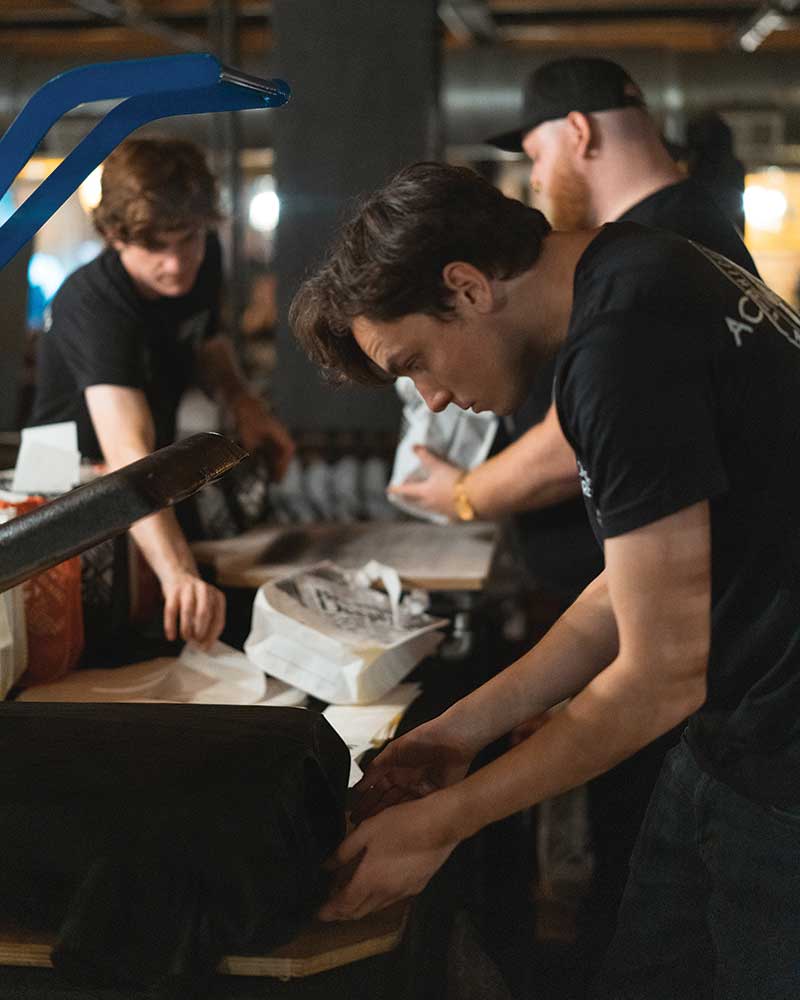
Axis Promotions (left)partnered with Royce Leather to offer live monogramming at an American Express customer appreciation event. Rowboat Creative (right) has worked with a number of brands to offer live customization at their events.
With a captive audience, it’s easier to impart your brand message. “It’s hard to keep human beings’ attention nowadays,” says Rich Santo, CEO of Chicago-based decorator Culture Studio. “Having them wait in line for something retains their attention for a little bit.” It also enables marketers to extract valuable customer data right from the source. People waiting in line will generally be more than willing to leave an email address and other contact information as part of a form outlining how they want their item personalized.
Another benefit of live printing relates to inventory, says Justin Moore, chief operating officer of Barrel Maker Printing (asi/528531), a decorator in Chicago that also owns and operates the web domain liveprinting.com. “You don’t necessarily have to worry about size breakdown or having a bunch of shirts left over, since it’s print on demand,” he says. “If the leftovers are blank, they can be restocked and used for a regular shirt order.”
“When people have the opportunity to take part … there’s way more benefit to the brand.”Lucas Guariglia, Rowboat Creative
Of course, apparel decorators have been aware of the power of onsite customization for decades. Brian Cole of Georgia Promotions, an affiliate of Top 40 distributor AIA Corporation (asi/109480), has been loading up blank garments, transfers and a heat press into a trailer and traveling to track and cross country sporting events in greater Atlanta for 20 years. “It’s a lot of work to put together, but once you’re out there, it’s fun,” he says. “People buy a shirt and they’re happy, like they’re buying ice cream.”
But it wasn’t until the mid-2000s that live screen printing really became a conduit for experiential marketing. By many accounts, it’s a movement that came right out of the Los Angeles arts scene. Hit + Run, for example, was born in the summer of 2005, when Flower was asked to set up his screen-printing equipment at a backyard barbecue. “Everyone was lined up for the whole night,” Flower recalls.
Flower and his friend and Hit + Run co-founder Mike Crivello realized they were on to something. By November of that year, Hit + Run had debuted professionally at an art walk in Long Beach. A second event for an online radio station soon followed. In the beginning, Flower says, “It was very community-oriented. We would sell 10 T-shirts and give away 30. It was never really a huge money-making dynamic.”
Then, Red Stripe beer contacted the duo and asked them to help the brand launch a new 40-ounce beer. “They wanted to do a series of events in six different U.S. cities and wanted to know if we could take our press on the road and print in all of them,” Flower says.
That event really introduced the company to the corporate world. Since then, Flower says, Hit + Run has done thousands of events around the world. “We’ve printed on the side of snowy mountains, on boats, in small, dark clubs. … Last year, we did an event for Uber where they wanted us to print in 13 cities simultaneously for the launch of their new branding.”
For live decoration to be truly successful experiential marketing, however, you have to move beyond the mindset of merely slapping a large, static logo across the chest of a basic tee. Brands have to be willing to let end-users experiment. Ink + Cotton, for example, will typically have a handful of different designs that play off various brand imagery, whether it’s company colors, the actual logo or some other abstract element. “The idea is you can get any combination of prints you want, anywhere you can print them,” Ellis says. “You might get a design and ask us to print it at a 45-degree angle. … What you get is yours and truly one of a kind.”
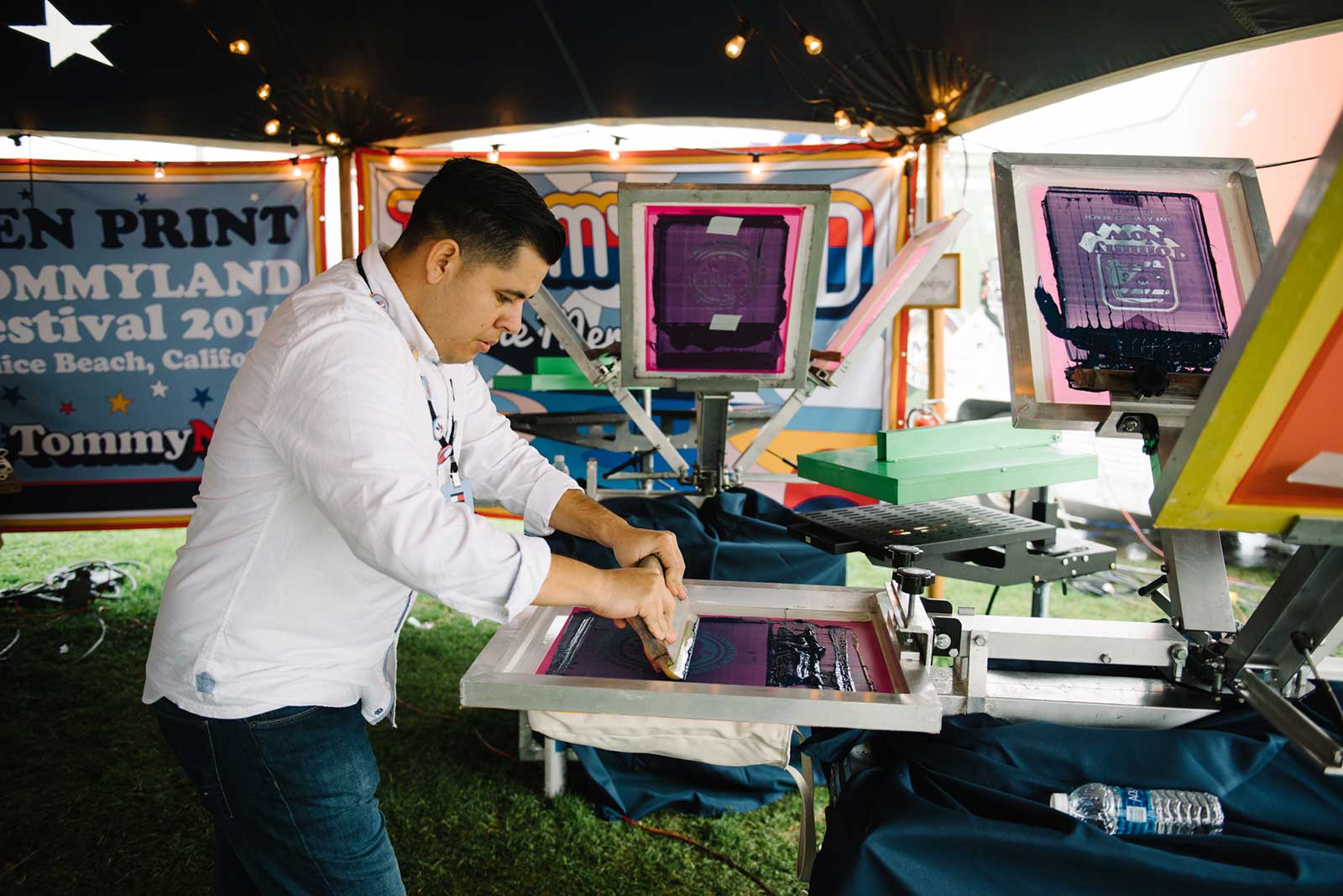
Don’t expect the trend of live decoration to die down anytime soon. In many ways, the concept has been growing as decorators and marketers collaborate to create ever more interactive, immersive experiences – like handing out spray paint and stencils for some DIY designing, or setting up tablet kiosks so guests can create their own digital direct-to-garment artwork at the swipe of a finger.
The most recent iteration comes from the retail sector. The prospect of snagging a unique, personalized garment has boosted foot traffic in traditional brick-and-mortars struggling to stay afloat in a sea of online competition. Champion Sportswear, for example, hosts live screen-printing events each month at its stores, facilitated by Hit + Run. And for the luxury market, Royce offers in-store monogramming services at Saks Fifth Avenue and Bloomingdale’s in Manhattan.
“What you get is yours and truly one of a kind.”Kyle Ellis, Ink + Cotton
Live decorating fits neatly within the zeitgeist of the younger generations, eager for experience over ownership and self-expression over conformity.
“Millennials and Gen Z are so hyper-focused on their own reality and their own way that they can stand out,” Flower says. “They want something not just customized, but personalized. It’s not requested, it’s demanded.”
And smart distributors and brands are more than happy to deliver on that demand.
5 Tips for Live Decoration
Coordinating a successful live decoration event involves a lot of moving parts and requires strong organizational skills. Consider these elements if you plan to give it a whirl.
